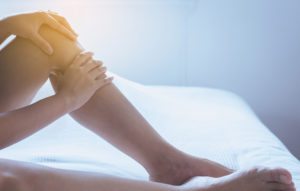Do you have tired, heavy legs? Sometimes, symptoms of vein disease are very obvious, like when you notice bulging, dark veins on your legs. But other times, the symptoms are less visible. At the end of the day, do your legs just feel off? Are they tired, and feeling very heavy? Have you been diagnosed with restless leg syndrome?

Tired, achy legs are actually a symptom of vein disease!
As it turns out, all of those symptoms are signs of venous reflux disease. Which means, if your answers are yes, it’s time to see your Houston vein specialists. That’s because you may have been suffering from this condition for quite some time, even if you haven’t seen physical symptoms.
When your legs are healthy, the valves in the leg veins open and close well, helping blood return back to your heart. When you have venous reflux, however, the valves don’t function fully. This allows blood to flow back down into your legs, pooling and stretching your veins. And, over time, you will start to notice varicose veins, even if they haven’t yet appeared.
Why? Varicose veins become swollen, twisted and sometimes painful because they are filled with too much blood. People may think that varicose veins are just a cosmetic issue, but they are actually one more symptom of reflux disease, a condition that can become debilitating if allowed to progress.
If you're not sure what we mean by heavy legs, think of it this way. When you walk, does it feel like you're wearing ankle weights? Then you're dealing with this vein disease symptom, which could also be a sign of poor circulation.
With poor circulation, your lower extremities may not get enough oxygen-rich blood to support your activity. Which is why a day on your feet could leave you with heavy legs. We call this condition venous insufficiency (VI.) And, like venous reflux, you need to treat VI early on or your symptoms will progress and worsen.
Additionally, with vein disease, blood sits in your lower extremities for longer than it should. This symptom alone can weigh down your lower body. And that makes your legs feel heavy.
Left alone, VI could give also cause pain, itching, swelling (edema), cramps, changes in skin color, and (you guessed it!) varicose veins! But wait, it gets worse. VI and other forms of vein disease also increase your risk for blood clots, a potentially life threatening development.
If you have symptoms of venous reflux or insufficiency, we can perform a diagnostic ultrasound to get you a confirmed diagnosis. And if that diagnosis is venous reflux disease, we can start treatment right away.
Initially, we start with conservative treatment options like support stockings—especially if you don’t yet have visible symptoms. We may also help you begin a weight loss and exercise regimen, to take some of the pressure off your hard working veins and to help strengthen legs muscles that will push blood up where it belongs. And we’ll make sure you’re putting up your legs whenever possible.
Of course, these measures won’t cure venous reflux—they’ll just help manage symptoms and they may prevent disease progression. Patients who are seeking a permanent solution to their venous reflux can schedule a consultation with Drs. Fox, Hardee or Valenson to see which of our minimally invasive vein treatment options will best suit their needs.

Scheduling
Please contact our dedicated specialists to schedule a consultation today.
2025 Texas Endovascular. All rights reserved. Website Design by Healthcare Success